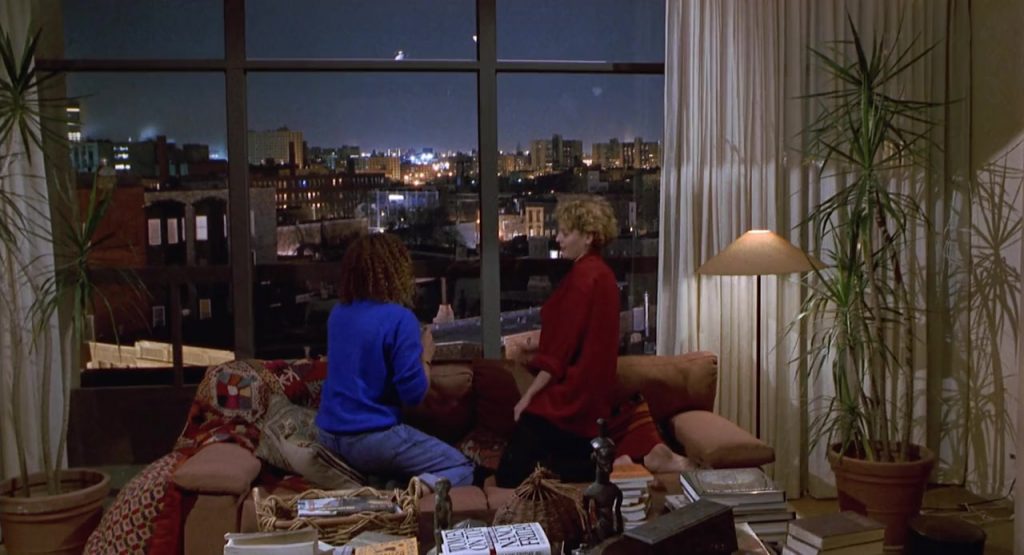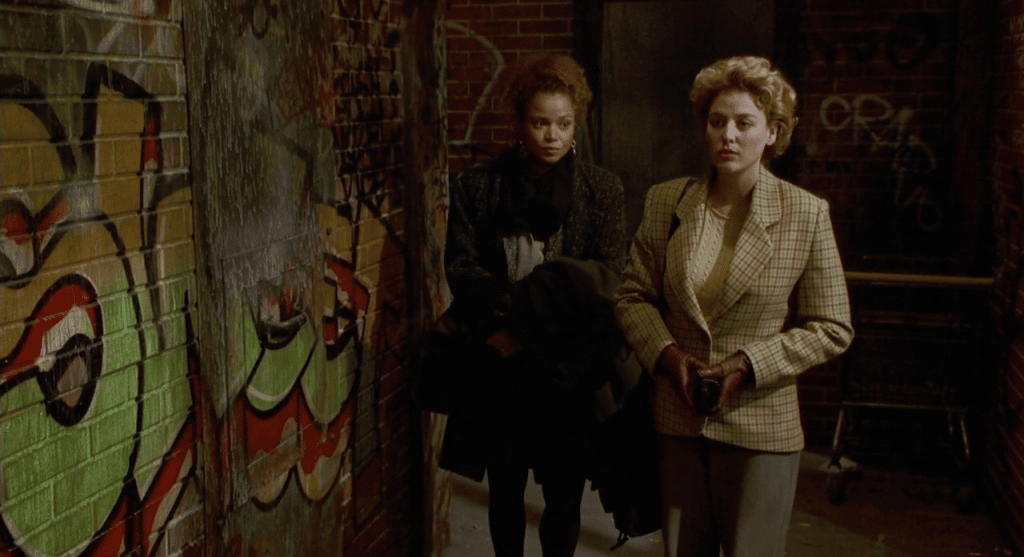28 years later, Bernard Rose’s look at socio-economic disparity lingers the most in its skewering of the white savior.
Built in 1970 and finished in 1973, Chicago’s Sears Tower was the epitome of neoliberalism. Whereas the other, more traditionally liberal buildings were humble and for the people, this one was better. It was bigger, taller, providing more room while taking up less space. It even beat out the Empire State Building with its 1,450 feet. Suffice it to say its edifice knew no bounds. But while it already dwarfed its sky like a capitalist Godzilla, it added antennas to grow another 279. The result was an onyx symbol that, with all its simplicity, said, “Come to me. Be my victim.”
And it continued to do so. It shouted at those in submission, laughing at those living in the husk of its layout. It’s in Bernard Rose’s Candyman that the tower stands on top, and while its source—“The Forbidden” by Clive Barker—took place in England, it’s hard to imagine Rose’s film anywhere but Chicago. The city was a home for many who escaped the Civil War. It housed disenfranchised, the minorities, and the Rainbow Coalition in the late 1960s and early ‘70s. Then, to use a more recent case example, came the opposite with the likes of Hillary Clinton and Rahm Emanuel. They, despite their intentions, stuck up for themselves in the guise of helping the Other. Ivory replaced onyx and rose-tinted glasses became even more of a commodity than black-and-white ethics.

Truth be told, I have a hard time seeing anything too different in Helen Lyle (Virginia Madsen). She’s a white savior with overinflated self-importance who, despite thinking she’s helping her community, uses others to cushion her intellectualism. She wants to know things, sure, but she doesn’t fully care. “Have you heard of him?” she asks a Black custodian nine minutes into the movie. “Can I talk to them?” she queries less than a minute later.
She doesn’t have the most interest in direct interactions, to say the least. Maybe it’s because she sees the “villain” as little more than a racist mythology that intrudes white, affluent suburbs. Maybe it’s because she’s all too drawn into an urban legend playing into affluent fears of the Other. Either way, she’s far from whom these legends were written for, and according to Silaine Lopes Souza’s research of Marxist theorist Frantz Fanon, the latter’s essays describe the following:
Fanon theorized that in the context of colonization—which also implies racism and discrimination—the colonized feels inferior and attempts to recapture his/her humanity and sense of self by seeking to be like the colonizer. The social elements that reinforce the notion of the colonizer’s inferiority are initially seen language, literature, folklore, and legends. From the Eurocentric perspective, the Black person was usually described as evil, brutish, savage, animalistic, and oversexual. White people or the colonizers were, on the other hand, portrayed as good, intelligent, and adventurers. Such language depiction serves to reinforce the sense of inferiority in the colonized, but it also creates a distinction between groups based on racial premises.
Thus comes Helen’s thesis. And no, it’s not from these words—she’s too lacking in self-awareness for that to be the case.
It’s an unconscious ideology instead: the idea of the underprivileged coping with their hardships by projecting the world’s evil onto a mythical figure. It isn’t mythical, though: almost two dozen have died. One woman was slashed from groin to gullet with a hook while her baby was never found. But this doesn’t really matter, at least not in the eyes of the ethnographer that is the Neoliberal. No, no. As her best friend, Bernadette (Kasi Lemmons), puts it, it’s just another case study, another barrier “like the L train to keep the ghetto out.”

“Helen, this is sick! This isn’t one of your fairy tales. A woman got killed here,” she later says. She sees her friend’s obsessions. She watches Helen’s colleagues use their knowledge of the less fortunate as a window into just how brilliant they are. Alongside the viewer, she also sees the tribal masks hanging on Helen’s walls as gentrified décor without any sense of context or larger implication, and as she asks Helen how much she paid for her apartment, her friend responds, “Don’t ask,” as if to say, “I don’t know, but it doesn’t really matter, does it? I have it and I know that others don’t.” This myopia is Helen’s rose-tinted glasses, but it’s unfortunate that this is her story and not Bernadette’s. That’s what makes Candyman so salient.
Thematically speaking, it’s serendipitous that Madsen was originally meant to play Bernadette while Alexandra Pigg, then Rose’s wife, was to play Helen. Rose then rewrote the former part to be a woman of color, which stopped Madsen from having either role. But then Pigg and Rose got pregnant; once the two began expecting, Pigg dropped out and Madsen got the part of Helen. Lemmons later stepped in as Bernadette, and then came one of the film’s most telling dynamics.

There’s a consistency to how Helen interacts with Black people that shows her selfishness, and it’s most apparent in her dynamic with Bernadette. It isn’t just a lack of self-awareness (although that’s definitely part of it). It’s how, while Helen treats Bernadette as a friend, she mostly treats her as a conduit to people of color. This, by her own doing, reduces her to a way for Helen to gain confidence in settings foreign to her.
She takes Bernadette to Cabrini-Green; she uses her as a sidekick in case their unintentional undercover cop garb doesn’t work. When project resident Anne-Marie (Vanessa Williams) confronts the grad student and tells her that “whites only come here to cause us a problem,” Helen further implicates her friend. “Believe me, that’s not what we’re here to do,” she says, unintentionally stripping Bernadette—who just happens to be light-skinned—of her racial identity by latently declaring her to be more white than Black, as if by association.
And it’s frightening. It isn’t just because of her ignorance, though; it’s because of how she panders to others. I think of Hillary Clinton in 2016 when she appeared as a guest on The Breakfast Club and the hosts asked her, “What’s something you always keep in your bag?” to which she responded, “Hot sauce!” One of the panel members brought up that some will see this as pandering to Black people. Clinton’s response? To put on an accent and say, “Okay… Is it workin’?!”
I think of the times that Rahm Emanuel, Mayor of Chicago from 2011 to 2019, despite positing himself as a leftist hero, closed clinics and harmed predominately Black neighborhoods. I think of his recently published article for The Washington Post—which Jeff Bezos owns—on why “Medicare-for-all is a pipe dream.” I think of their viewpoints that go from selfishness to amorality, from amorality to immorality.
Helen, like the Clintons and Emanuels of the world, can’t be wrong in Candyman. She can’t be the lesser brain in the room, can’t exist in an interaction where her own wishes aren’t a projection onto others. She’s a magician who uses social justice as a parlor trick instead, ignoring the past and only focusing on the present as if that will undo the atrocities throughout history.
And all the while, the Sears Tower looks over them. It seems to project its influence onto Helen, more and more until she loses her systemically tinged agency and falls deeper into the folklore she investigates. The police officers that arrest her for alleged murder are Black; the police chief is as well. Soon enough, we hear the voice of Candyman rasping at our spines. “You were not content with the stories, so I was obliged to come,” he grizzles at one point. “Believe in me. Be my victim,” he says—nay, begs—to her later on, yearning for the white person to see him. As flawed, as real, as crucial in history, as not defined by his race but a part of a larger collective.

But she only sees any sort of Other when she needs to: when she can benefit from it, when she can summon the fear of the Black man to escape from her own misfortunes as she does after her admission to a psych ward. She runs, hiding from more and more from people of color as her own relationship with her husband, Trevor (Xander Berkeley), starts to unravel. She wears a hook, appropriating the imagery of Candyman’s torture and demise to climb the pyre of Cabrini-Green, only for young Jake (Dejuan Guy) to gaze upon her. “He’s here,” he whispers as the Sears Tower dwarfs their—and her—efforts.
And as Candyman reaches to Helen and tries to reclaim her as his long lost love, the Neoliberal dies in the literal sense: a charred, scalped white woman evoking and toying with the racist imagery of 1920s and ‘30s cinema. But as she dies, Candyman, more empathic in morals and backstory, survives, undoing the tropes of King Kong and The Birth of a Nation. He further revolts against the conservatism that gave way to Reagan-era ethics and ‘90s neoliberalism.

It’s almost as beautiful as it is sad. It’s terrifying too, like a reminder of what came before and a look at what could come in the future. Soon enough, Cabrini-Green residents burn both Candyman and Helen down in the spine of their community. They exercise reparations against their oppressors and exorcise the evil that their Other has prescribed them. They even come to Helen’s funeral, dropping the urban legend’s rusty hook onto her grave as if to displace the violence that society has projected on to themselves back away from them.
Back on to Helen, on to the spirit that provoked it. Back on her invasiveness that stoked the flames as if to say, “Someone, please see me as revolutionary for pointing out what’s been obvious the entire time.” This loneliness would almost be pitiful if the film didn’t unconsciously juxtapose it against the needs of Candyman himself. And that’s exactly the point.
But as white people and Black people look upon each other with a happenstance martyr between them, no direct interactions occur. The Bernadettes of the world have been killed. Empathy has fallen victim to Helen’s ethnography. Culture has burned at the stake of clash. There’s no in-between, and just as the Helen the oppressor lacks any direct interactions, she overtakes the mural. She is the urban legend, the boogeyman, the savior of a legacy whose only hope is to be hopeful.
Yes, Helen is dead. But the chances that people will study her rather than the atrocities she buried is a blade to the heart.